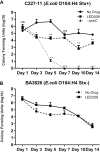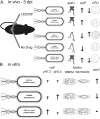QseC Signaling in the Outbreak O104:H4 Escherichia coli Strain Combines Multiple Factors during Infection
- PMID: 31235511
- PMCID: PMC6689295
- DOI: 10.1128/JB.00203-19
QseC Signaling in the Outbreak O104:H4 Escherichia coli Strain Combines Multiple Factors during Infection
Abstract
Enteroaggregative Escherichia coli (EAEC) from the O104:H4 specific serotype caused a large outbreak of bloody diarrhea with some complicated cases of hemolytic-uremic syndrome (HUS) in Europe in 2011. The outbreak strain consisted in an EAEC capable to produce the Shiga toxin (Stx) subtype 2a, a characteristic from enterohemorrhagic E. coli QseBC two-component system detects AI-3/Epi/NE and mediates the chemical signaling between pathogen and mammalian host. This system coordinates a cascade of virulence genes expression in important human enteropathogens. The blocking of QseC of EAEC C227-11 (Stx+) strain by N-phenyl-4-{[(phenylamino) thioxomethyl]amino}-benzenesulfonamide (also known as LED209) in vivo demonstrated a lower efficiency of colonization. The periplasmic protein VisP, which is related to survival mechanisms in a colitis model of infection, bacterial membrane maintenance, and stress resistance, here presented high levels of expression during the initial infection within the host. Under acid stress conditions, visP expression levels were differentiated in an Stx-dependent way. Together, these results emphasize the important role of VisP and the histidine kinase sensor QseC in the C227-11 (Stx+) outbreak strain for the establishment of the infectious niche process in the C57BL/6 mouse model and of LED209 as a promising antivirulence drug strategy against these enteric pathogens.IMPORTANCE EAEC is a remarkable etiologic agent of acute and persistent diarrhea worldwide. The isolates harbor specific subsets of virulence genes and their pathogenesis needs to be better understood. Chemical signaling via histidine kinase sensor QseC has been shown as a potential target to elucidate the orchestration of the regulatory cascade of virulence factors.
Keywords: EAEC; Escherichia coli; O104:H4; QseC; Shiga toxin; VisP; chemical signaling.
Copyright © 2019 American Society for Microbiology.
Figures







Similar articles
-
Human microbiota modulation via QseC sensor kinase mediated in the Escherichia coli O104:H4 outbreak strain infection in microbiome model.BMC Microbiol. 2021 Jun 2;21(1):163. doi: 10.1186/s12866-021-02220-3. BMC Microbiol. 2021. PMID: 34078285 Free PMC article.
-
Comparative virulence characterization of the Shiga toxin phage-cured Escherichia coli O104:H4 and enteroaggregative Escherichia coli.Int J Med Microbiol. 2018 Oct;308(7):912-920. doi: 10.1016/j.ijmm.2018.06.006. Epub 2018 Jun 19. Int J Med Microbiol. 2018. PMID: 29941383
-
Escherichia coli O104:H4 Pathogenesis: an Enteroaggregative E. coli/Shiga Toxin-Producing E. coli Explosive Cocktail of High Virulence.Microbiol Spectr. 2014 Dec;2(6). doi: 10.1128/microbiolspec.EHEC-0008-2013. Microbiol Spectr. 2014. PMID: 26104460 Review.
-
Pro-inflammatory capacity of Escherichia coli O104:H4 outbreak strain during colonization of intestinal epithelial cells from human and cattle.Int J Med Microbiol. 2018 Oct;308(7):899-911. doi: 10.1016/j.ijmm.2018.06.003. Epub 2018 Jun 19. Int J Med Microbiol. 2018. PMID: 29937390
-
Characteristics of the Shiga-toxin-producing enteroaggregative Escherichia coli O104:H4 German outbreak strain and of STEC strains isolated in Spain.Int Microbiol. 2011 Sep;14(3):121-41. doi: 10.2436/20.1501.01.142. Int Microbiol. 2011. PMID: 22101411 Review.
Cited by
-
Escherichia coli as a Multifaceted Pathogenic and Versatile Bacterium.Front Cell Infect Microbiol. 2020 Dec 21;10:548492. doi: 10.3389/fcimb.2020.548492. eCollection 2020. Front Cell Infect Microbiol. 2020. PMID: 33409157 Free PMC article. Review.
-
The Release of Norepinephrine in C57BL/6J Mice Treated with 6-Hydroxydopamine (6-OHDA) is Associated with Translocations in Enteric Escherichia coli via the QseC Histidine Kinase Receptor.Med Sci Monit. 2020 Aug 7;26:e922986. doi: 10.12659/MSM.922986. Med Sci Monit. 2020. PMID: 32764532 Free PMC article.
-
Bacterial signaling as an antimicrobial target.Curr Opin Microbiol. 2020 Oct;57:78-86. doi: 10.1016/j.mib.2020.08.001. Epub 2020 Sep 8. Curr Opin Microbiol. 2020. PMID: 32916624 Free PMC article. Review.
-
Characterisation of the E. coli and Salmonella qseC and qseE mutants reveals a metabolic rather than adrenergic receptor role.FEMS Microbiol Lett. 2022 Mar 4;369(1):fnac012. doi: 10.1093/femsle/fnac012. FEMS Microbiol Lett. 2022. PMID: 35137015 Free PMC article.
References
-
- Gould LH, Demma L, Jones TF, Hurd S, Vugia DJ, Smith K, Shiferaw B, Segler S, Palmer A, Zansky S, Griffin PM. 2009. Hemolytic uremic syndrome and death in persons with Escherichia coli O157:H7 infection, foodborne diseases active surveillance network sites, 2000-2006. Clin Infect Dis 49:1480–1485. doi:10.1086/644621. - DOI - PubMed
Publication types
MeSH terms
Substances
LinkOut - more resources
Full Text Sources
Medical

